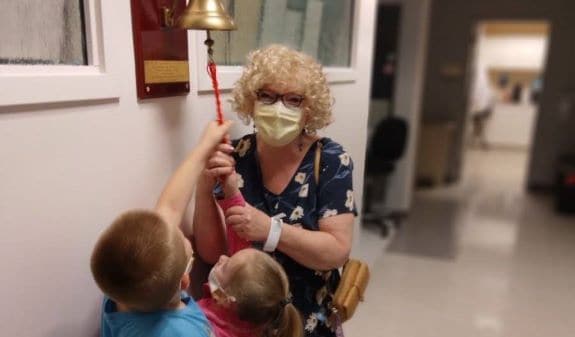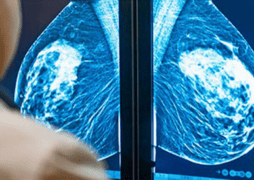Sometimes, certain neighborhoods or towns appear to have more breast cancer than others. The Centers for Disease Control and Prevention (CDC) defines a cancer cluster as a greater than expected number of cancer cases occurring within a group of people in a geographic area over a period of time.1 When an excess number of cancers occurs, it is important to learn whether something specific to the area may be the cause.
Cancer basics
Before looking more closely at cancer clusters, it is important to understand a few things about cancer.
- Cancer is not a single disease. Not only does breast cancer differ from lung cancer or leukemia, there are many types of breast cancer. When scientists look for clusters, they look for clusters of a certain type of cancer, not just cancer in general.
- Most cancers develop over many years and are not likely due to a recent behavior or a recent contact with something in a person’s environment. And, people living in the same neighborhood may have very different levels of exposure to the same surroundings. If you have lived in the same home for 10 years, you have had more exposure to your surroundings than someone who has only lived in the neighborhood for six months.
- Breast cancer is not rare. One in eight women in the United States will likely be diagnosed in her lifetime (up to age 85).2 So, in a neighborhood with 100 women you would expect to have a few cases of breast cancer over time.
Although these challenges can make studying cancer clusters difficult, they also help us to understand why a group of people getting cancer in a neighborhood may not necessarily be a cluster.
What is a cancer cluster?
To be defined as a cluster, all the cancer cases must be one of the following:1
- The same type of cancer (for example, breast cancer)
- A rare type of cancer (for example, inflammatory breast cancer)
- A cancer not usually seen in certain groups of people (for example, breast cancer in men)
Thus, if several people in your neighborhood have been diagnosed with cancer, but they have different types of cancer (for example, one person has lung cancer, another breast cancer and another leukemia), it is not a cancer cluster.
How are cancer clusters identified and studied?
Starting at the source
Research into a possible cancer cluster usually begins at the state or local level. State and local health departments routinely collect cancer data through cancer registries. All state (and some local) health departments in the U.S. have a cancer registry that collects data on cancer cases and cancer deaths from hospitals, doctors’ offices and other medical centers. So, health departments are often the first to suspect a cancer cluster when they see a higher than expected number of cancer cases in a certain area. You may also report a suspected cancer cluster directly to your local or state health departments to begin an investigation.
Using collected cancer data, health departments can determine whether there is a true cancer cluster. Many cancers, including breast cancer, are not uncommon and often what may appear to be a cluster of cancer actually may be close to the expected number of cancers in an area (according cancer registry and census data).
Even when a cancer cluster is identified, the cancers may not be due to a single factor. A cluster may be due to:1
- Measurement problems (cancer was not well defined or the number of cases were not counted correctly)
- Known risk factors
- Unknown risk factors
- Chance
Research on cancer clusters may include surveys to learn more about the health, lifestyles and environmental exposures of people living in the cluster area. Research may also include blood or urine samples to look for markers of dietary, hormone, chemical or other types of exposures.
When a local or state health department identifies a cluster, it may contact the CDC for help in researching possible reasons behind the excess cancer cases in the area.
National tracking and coordination
Since the 1960’s, the CDC has studied reports of cancer clusters. The CDC has several systems in place to help identify and study cancer clusters (as well as clusters of other diseases). These include:3
National Center for Environmental Health (NCEH). The NCEH investigates reports of cancer clusters in the U.S.
National Environmental Public Health Tracking Network (Tracking Network). The Tracking Network follows data on many health conditions (including breast and other cancers) in 23 states and New York City and looks for worrisome patterns or clusters. It gathers together information and conducts research on environmental exposures (for example, in the air, water and soil) and levels of these exposures in the body. The Tracking Network combines these data to learn more about environmental factors and health.
What have we learned from breast cancer cluster studies?
Over the past 50 years, many clusters of cancer (including breast cancer) in the U.S. have been studied. Most of these have been related to worksite exposures. For example, factory workers exposed to high levels of the chemical benzene were found to have an increased risk of leukemia.3-4
To date, research on breast cancer clusters has found few residential environmental exposures related to risk. However, these studies have yielded much useful information about known personal, lifestyle and reproductive risk factors.
Two of the best-studied breast cancer clusters are in Long Island, New York and Marin County, California (San Francisco Bay area).5-6 In the 1990’s, rates of new cases of breast cancer were higher than expected in these areas. So, these breast cancer clusters were reported and investigated. Many studies looked at known risk factors and possible environmental factors that might be related to the excess number of breast cancer cases in these areas. These factors included pesticides, industrial chemicals and electromagnetic fields (EMF).
Known risk factors
Findings from the Long Island and Marin County studies showed the excess breast cancers in both areas were mainly due to known risk factors. Living on Long Island or in Marin County did not appear to increase the risk of breast cancer. Rather, women who lived in these areas and developed breast cancer were more likely to have known risk factors compared to other women. These women were more likely to:
- Be older5,7-8
- Be white8
- Have Ashkenazi Jewish heritage9
- Have a family history of breast cancer5,7
- Be older when they first gave birth to a child5,7,9-11
- Never have given birth5,7-11
- Have a higher socioeconomic status (higher income or higher education level) 5,7-8,11-12
- Drink alcohol10-9,11
- Use postmenopausal hormones13 (From 1999 to 2004, breast cancer rates in Marin County declined and were similar to those in other parts in California.9,13 This decline appeared to be due, in part, to large declines in the use of postmenopausal hormones in the area.13-14)
Environmental factors
Although researchers looked for environmental factors that might help explain the cancer clusters on Long Island and in Marin County, most of these factors were not found to be related to breast cancer risk including:
- Organochlorine pesticides, such as DDT, DDE, dieldron and chlordane15-17
- Industrial chemicals, such as polychlorinated biphenyl (PCB)15-17
- EMF, such as power lines and electric blankets16-18
Findings from one of the Long Island studies suggested exposure to polycyclic aromatic hydrocarbons (PAH), a chemical found in cigarette smoke and grilled foods, slightly increased the risk of breast cancer.19 More recent studies on PAH and breast cancer risk have not confirmed these findings.20-21 This topic remains under active study.
Unanswered questions
We are exposed to many different things in our daily lives that may affect our risk of breast cancer. Although clusters are often due to known risk factors or to chance, they can also help call attention to new or previously unstudied factors that may impact risk. Cluster studies continue to be an important part of breast cancer research, exploring how a range of different environmental and other factors are related to risk.
Many places in the U.S. are under study for possible cancer or other disease clusters. For example, Camp Lejeune military base in North Carolina is being studied as an area near a contaminated water treatment plant. 22
Conclusions
According to Dr. Sue Hankinson, Professor of Epidemiology at the School of Public Health and Health Sciences, University of Massachusetts Amherst, “The evaluation of possible cancer clusters is very important but can also be exceptionally challenging. Frequently the number of cases identified is small, how to geographically define the cluster is uncertain, and the exposures of interest can be difficult to quantify. In addition, as noted above, it is critical to take the profile of known risk factors into account — a higher cancer rate can occur simply because the population at hand has higher levels of known risk factors (such as, alcohol consumption or postmenopausal hormone use for breast cancer). Luckily, because of complete cancer registration throughout the US, geographic variations in cancer rates can be monitored on a routine basis – this is not true for most other chronic diseases. This routine monitoring helps researchers identify and investigate breast cancer clusters in a timely and thorough manner.”
Learn more about breast cancer and cancer clusters in your area
The CDC’s Tracking Network’s interactive website is a good place to learn how your state compares to other states in terms of breast cancer rates and certain environmental exposures (https://ephtracking.cdc.gov/).
Your state or local department of public health website may provide information on local breast cancer rates (as well as rates of other types of cancers and health conditions, such as asthma). It may also offer summaries of past and ongoing cancer cluster investigations. The CDC offers a list of links to all state (and many local) departments of public health (https://www.cdc.gov/environmental-health-tracking/php/our-work/index.html).
References
1. Centers for Disease Control and Prevention (CDC). Environmental hazards & health effects: cancer clusters. CDC. https://www.cdc.gov/cancer-environment/about/index.html, 2011.
2. American Cancer Society. Cancer Facts & Figures 2011. American Cancer Society, 2011.
3. Rinsky RA, Smith AB, Hornung R, et al. Benzene and leukemia. An epidemiologic risk assessment. N Engl J Med. 316(17):1044-50, 1987.
4. International Agency for Research on Cancer (IARC). IARC Monographs on the Evaluation of Carcinogenic Risks to Humans, Volume 29. Some industrial chemicals and dyestuffs: summary of data reported and evaluation. World Health Organization IARC, 1998.
5. National Cancer Institute. Questions and Answers about the Breast Cancer and the Environment on Long Island Study. http://www.cancer.gov/newscenter/qa/2002/long-island-environmentqa, 2008.
6. Clarke CA, Glaser SL, West DW, et al. Breast cancer incidence and mortality trends in an affluent population: Marin County, California, USA, 1990-1999. Breast Cancer Res. 4(6):R13, 2002.
7. Gammon MD, Neugut AI, Santella RM, et al. The Long Island Breast Cancer Study Project: description of a multi-institutional collaboration to identify environmental risk factors for breast cancer. Breast Cancer Res Treat. 74(3):235-54, 2002.
8. Prehn AW, West DW. Evaluating local differences in breast cancer incidence rates: a census-based methodology (United States). Cancer Causes Control. 9(5):511-7, 1998.
9. Lea CS, Gordon NP, Prebil LA, Ereman R, Uratsu CS, Powell M. Differences in reproductive risk factors for breast cancer in middle-aged women in Marin County, California and a sociodemographically similar area of Northern California. BMC Womens Health. 9:6, 2009.
10. Robbins AS, Brescianini S, Kelsey JL. Regional differences in known risk factors and the higher incidence of breast cancer in San Francisco. J Natl Cancer Inst. 89(13):960-5, 1997.
11. Keegan TH, Chang ET, John EM, et al. Recent changes in breast cancer incidence and risk factor prevalence in San Francisco Bay area and California women: 1988 to 2004. Breast Cancer Res. 9(5):R62, 2007.
12. Reynolds P, Hurley SE, Quach AT, et al. Regional variations in breast cancer incidence among California women, 1988-1997. Cancer Causes Control. 16(2):139-50, 2005.
13. Robbins AS, Clarke CA. Regional changes in hormone therapy use and breast cancer incidence in California from 2001 to 2004. J Clin Oncol. 25(23):3437-9, 2007.
14. Ereman RR, Prebil LA, Mockus M, et al. Recent trends in hormone therapy utilization and breast cancer incidence rates in the high incidence population of Marin County, California. BMC Public Health. 10:228, 2010.
15. Krieger N, Wolff MS, Hiatt RA, Rivera M, Vogelman J, Orentreich N. Breast cancer and serum organochlorines: a prospective study among white, black, and Asian women.
J Natl Cancer Inst. 86(8):589-99, 1994.
16. Gammon MD, Wolff MS, Neugut AI, et al. Environmental toxins and breast cancer on Long Island. II. Organochlorine compound levels in blood. Cancer Epidemiol Biomarkers Prev. 11(8):686-97, 2002.
17. Kabat GC, O’Leary ES, Schoenfeld ER, et al. for the EMF and Breast Cancer on Long Island Study Group. Electric blanket use and breast cancer on Long Island. Epidemiology. 14(5):514-20, 2003.
18. Electromagnetic fields and breast cancer on Long Island: a case-control study.
Schoenfeld ER, O’Leary ES, Henderson K, et al for the EMF and Breast Cancer on Long Island Study Group. Am J Epidemiol. (1):47-58, 2003.
19. Gammon MD, Santella RM, Neugut AI, et al. Environmental toxins and breast cancer on Long Island. I. Polycyclic aromatic hydrocarbon DNA adducts. Cancer Epidemiol Biomarkers Prev. 11(8):677-85, 2002.
20. Lee KH, Shu XO, Gao YT, et al. Breast cancer and urinary biomarkers of polycyclic aromatic hydrocarbon and oxidative stress in the Shanghai Women’s Health Study. Cancer Epidemiol Biomarkers Prev. 19(3):877-83, 2010.
21. Gammon MD, Sagiv SK, Eng SM, et al. Polycyclic aromatic hydrocarbon-DNA adducts and breast cancer: a pooled analysis. Arch Environ Health. 59(12):640-9, 2004.
22. Agency for Toxic Substances and Disease Registry. Camp Lejeune, North Carolina. Centers for Disease Control and Prevention and U.S. Department of Health and Human Services. http://www.atsdr.cdc.gov/sites/lejeune/, 2011.



